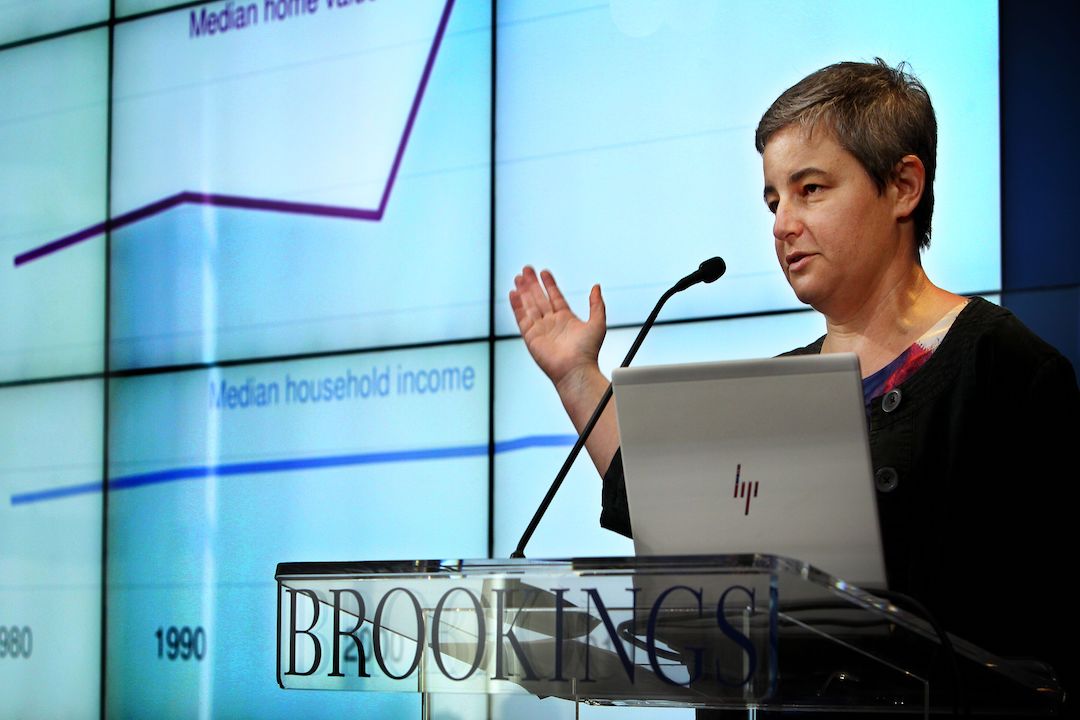By Tatyana Hopkins
Housing prices across the national capital region are increasing faster than household incomes, and this is due in part to population growth almost doubling housing unit growth between 2000 and 2017, said Leah Brooks, director of the George Washington University Center for Washington Area Studies (CWAS) and a professor in GW’s Trachtenberg School of Public Policy and Public Administration.
“If housing prices were rising, but income was, too, we wouldn't be so concerned,” she said, noting that the dwindling supply of affordable housing relative to population growth could negatively impact the area’s future economic vitality.
Dr. Brooks presented a new report, “The State of the Capital Region’s Housing,” at an event at the Brookings Institution. The report was a collaborative effort of researchers at CWAS, Brookings Institution, Fannie Mae and Georgetown University.
The report concluded that roughly half of the region’s housing growth between 2000 and 2017 was concentrated in a handful of exurban jurisdictions, namely, Virginia’s Loudoun and Prince William counties, which accounted for about 25 percent of the region’s housing growth over that period.
It also found that nearly two-thirds of the housing constructed within the same timeframe was single-family homes, which are typically more expensive than units for rent. Additionally, on average, residents in the area live in homes that cost about six times their household income, while the national housing price average is only about 3 times the household income. “We put out this report to say that local decisions about housing development have cumulative regional consequences, and we'd like to help policymakers think about those consequences in a regional framework,” Dr. Brooks said.
Following her presentation, at the May 20 event, a panel of experts discussed what local governments, developers and affordable housing advocates could do to make sure the region meets the housing needs of all its residents.
Ally Schweitzer, WAMU 88.5 FM’s business and development reporter, moderated the panel comprised of Andrew Jakabovics, vice president of Policy Development Enterprise Community Partners; Sarah Coyle Etro, assistant director of Loudoun County Department of Family Services; and A.J. Jackson, executive vice president of social impact investing at JBG Smith Properties.

From left to right: Ally Schweitzer, Andrew Jakabovics, Sarah Coyle Etro and A.J. Jackson.
Mr. Jackson, who leads JBG Smith’s efforts to produce affordable workforce housing, called for a regional approach to planning and funding for housing.
“People don't respect the jurisdictional boundaries when they're thinking about where to live or work,” he said. “So, we have to look at this issue regionally just like transit and set regional goals with contributions from the sub-jurisdictions.”
Additionally, he said there is a “strong link” between supply and affordability, noting that housing in the area is not being produced in line with the job creation taking place in the area.
“Lack of production coupled with changing demand about where people want to be has put some real pressure... on pricing,” Mr. Jackson said.
However, Mr. Jakabovics, who researches housing issues for a national nonprofit that focuses on creating housing opportunities for low-and-moderate-income people, said the region “can’t build [its] way out of the affordability challenges” it faces.
"The gap between what is getting built today and what would be considered affordable to most household… is wide, and it's not clear that even over time it is going to close,” he said.
He said although new supply is critical, “asking the market to provide it without also requiring… units explicitly for affordability” through inclusionary zoning policies or tax incentives, would not address the area’s housing shortage.
Mr. Jakabovics said in addition to providing developers with incentives to build dedicated affordable units, local governments should also reconsider some of the zoning regulations that restrict the types and amount of housing that can be built on particular plots of land.
“There is a lot of land that is zoned as single-family,” he said. “It's very hard to build anything other than a single-family home on a lot zoned single-family in most places, and when you get into more dense communities, there are also height restrictions and other factors that impede our ability to develop as densely as the market might seek to build.”
Ms. Etro said Loudoun County has planned its housing production “carefully” and has made efforts to “support development to keep prices affordable while keeping taxes low.”
She said the county is considering including housing production in its budget’s capital improvement program.
“We need [affordable housing,] and it’s important to our economy,” Ms. Etro said. “So, why not plan for it as we would plan for a road, community center or library.”




